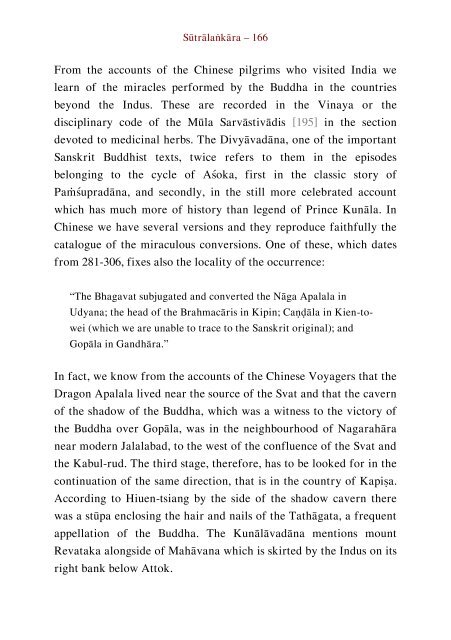Literary History of Sanskrit Buddhism
A study by J. K. Nariman of Sanskrit Buddhism from the Early Buddhist Tradition up to the Mahayana texts proper.
A study by J. K. Nariman of Sanskrit Buddhism from the Early Buddhist Tradition up to the Mahayana texts proper.
You also want an ePaper? Increase the reach of your titles
YUMPU automatically turns print PDFs into web optimized ePapers that Google loves.
Sūtrālaṅkāra – 166<br />
From the accounts <strong>of</strong> the Chinese pilgrims who visited India we<br />
learn <strong>of</strong> the miracles performed by the Buddha in the countries<br />
beyond the Indus. These are recorded in the Vinaya or the<br />
disciplinary code <strong>of</strong> the Mūla Sarvāstivādis [195] in the section<br />
devoted to medicinal herbs. The Divyāvadāna, one <strong>of</strong> the important<br />
<strong>Sanskrit</strong> Buddhist texts, twice refers to them in the episodes<br />
belonging to the cycle <strong>of</strong> Aśoka, first in the classic story <strong>of</strong><br />
Paṁśupradāna, and secondly, in the still more celebrated account<br />
which has much more <strong>of</strong> history than legend <strong>of</strong> Prince Kunāla. In<br />
Chinese we have several versions and they reproduce faithfully the<br />
catalogue <strong>of</strong> the miraculous conversions. One <strong>of</strong> these, which dates<br />
from 281-306, fixes also the locality <strong>of</strong> the occurrence:<br />
“The Bhagavat subjugated and converted the Nāga Apalala in<br />
Udyana; the head <strong>of</strong> the Brahmacāris in Kipin; Caṇḍāla in Kien-towei<br />
(which we are unable to trace to the <strong>Sanskrit</strong> original); and<br />
Gopāla in Gandhāra.”<br />
In fact, we know from the accounts <strong>of</strong> the Chinese Voyagers that the<br />
Dragon Apalala lived near the source <strong>of</strong> the Svat and that the cavern<br />
<strong>of</strong> the shadow <strong>of</strong> the Buddha, which was a witness to the victory <strong>of</strong><br />
the Buddha over Gopāla, was in the neighbourhood <strong>of</strong> Nagarahāra<br />
near modern Jalalabad, to the west <strong>of</strong> the confluence <strong>of</strong> the Svat and<br />
the Kabul-rud. The third stage, therefore, has to be looked for in the<br />
continuation <strong>of</strong> the same direction, that is in the country <strong>of</strong> Kapiṣa.<br />
According to Hiuen-tsiang by the side <strong>of</strong> the shadow cavern there<br />
was a stūpa enclosing the hair and nails <strong>of</strong> the Tathāgata, a frequent<br />
appellation <strong>of</strong> the Buddha. The Kunālāvadāna mentions mount<br />
Revataka alongside <strong>of</strong> Mahāvana which is skirted by the Indus on its<br />
right bank below Attok.


















